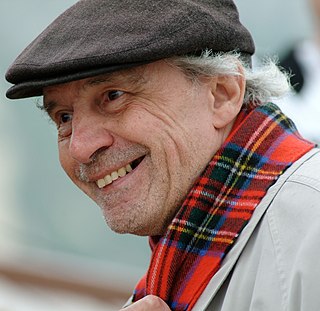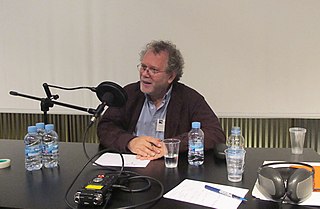
Cahiers du Cinéma is a French film magazine co-founded in 1951 by André Bazin, Jacques Doniol-Valcroze, and Joseph-Marie Lo Duca. It developed from the earlier magazine Revue du Cinéma involving members of two Paris film clubs—Objectif 49 and Ciné-Club du Quartier Latin.

French cinema consists of the film industry and its film productions, whether made within the nation of France or by French film production companies abroad. It is the oldest and largest precursor of national cinemas in Europe; with primary influence also on the creation of national cinemas in Asia.
Film theory is a set of scholarly approaches within the academic discipline of film or cinema studies that began in the 1920s by questioning the formal essential attributes of motion pictures; and that now provides conceptual frameworks for understanding film's relationship to reality, the other arts, individual viewers, and society at large. Film theory is not to be confused with general film criticism, or film history, though these three disciplines interrelate.

The New Wave, also called the French New Wave, is a French art film movement that emerged in the late 1950s. The movement was characterized by its rejection of traditional filmmaking conventions in favor of experimentation and a spirit of iconoclasm. New Wave filmmakers explored new approaches to editing, visual style, and narrative, as well as engagement with the social and political upheavals of the era, often making use of irony or exploring existential themes. The New Wave is often considered one of the most influential movements in the history of cinema.

Jacques Rivette was a French film director and film critic most commonly associated with the French New Wave and the film magazine Cahiers du Cinéma. He made twenty-nine films, including L'Amour fou (1969), Out 1 (1971), Celine and Julie Go Boating (1974), and La Belle Noiseuse (1991). His work is noted for its improvisation, loose narratives, and lengthy running times.
Serge Daney was a French movie critic. He was a major figure of Cahiers du cinéma which he co-edited in the late 1970s. He also wrote extensively about films, television, and society in the newspaper Libération and founded the quarterly review Trafic shortly before his death. Highly regarded in French and European film criticism circles, his work, remained little known to English-speaking audiences until recent translations. A first book-long interview, Postcards from the Cinema, was published in 2007 and a collection of his writings prior to 1982, The Cinema House and the World, was published in 2022.

André Pieyre de Mandiargues was a French writer born in Paris. He became an associate of the Surrealists and married the Italian painter Bona Tibertelli de Pisis. He was a particularly close friend of the painter Leonor Fini.

Jacques Feyder was a Belgian film director, screenwriter and actor who worked principally in France, but also in the US, Britain and Germany. He was a director of silent films during the 1920s, and in the 1930s he became associated with the style of poetic realism in French cinema. He adopted French nationality in 1928.

Raúl Ernesto Ruiz Pino was an experimental Chilean filmmaker, writer and teacher whose work is best known in France. He directed more than 100 films.

King Lear is a 1987 film directed by Jean-Luc Godard, an adaptation of William Shakespeare's play in the avant-garde style of French New Wave cinema. The script was primarily by Peter Sellars and Tom Luddy. It is not a typical cinematic adaptation of Shakespeare's eponymous tragedy, although some lines from the play are used in the film. Only three characters – Lear, Cordelia and Edgar – are common to both, and only Act I, scene 1 is given a conventional cinematic treatment in that two or three people actually engage in relatively meaningful dialogue.

Christine Buci-Glucksmann is a French philosopher and Professor Emeritus from University of Paris VIII specializing in the aesthetics of the Baroque and Japan, and computer art. Her best-known work in English is Baroque Reason: The Aesthetics of Modernity.

Olivier Cotte is a French writer, graphic novel scriptwriter, animation historian, illustrator, and a director.

Raphaël Bassan is a French film critic and journalist, who has specialized in experimental film and the history of cinema. He has also made three short movies.

Jacques Doniol-Valcroze was a French actor, critic, screenwriter, and director. In 1951, Doniol-Valcroze was a co-founder of the renowned film magazine Cahiers du cinéma, along with André Bazin and Joseph-Marie Lo Duca. The magazine was initially edited by Doniol-Valcroze between 1951–1957. As critic, he championed numerous filmmakers including Orson Welles, Howard Hawks, and Nicholas Ray. In 1955, then 23-year-old François Truffaut made a short film in Doniol-Valcroze's apartment, Une Visite. Jacques's daughter Florence played a minor part in it.

Georges Didi-Huberman FBA is a French philosopher and art historian.

Jean Douchet was a French film director, historian, film critic and teacher who began his career in the early 1950s at Gazette du Cinéma and Cahiers du cinéma with members of the future French New Wave.

Le Bal is an independent arts centre in Paris. It focuses on documentary photography, video, cinema and new media through exhibitions, production, book publishing, talks and debates.

This is a bibliography of articles and books by or about the director and film critic Jacques Rivette.
André Gaudreault is a Canadian film historian and theorist who holds the Canada Research Chair in Film and Media Studies.
Les Cahiers de la photographie, published between 1981 and 1994 was a French magazine devoted to photography with the goal of promoting criticism of contemporary photography.
















